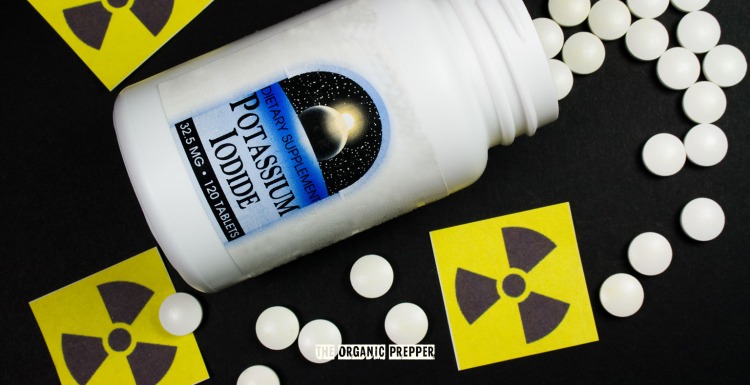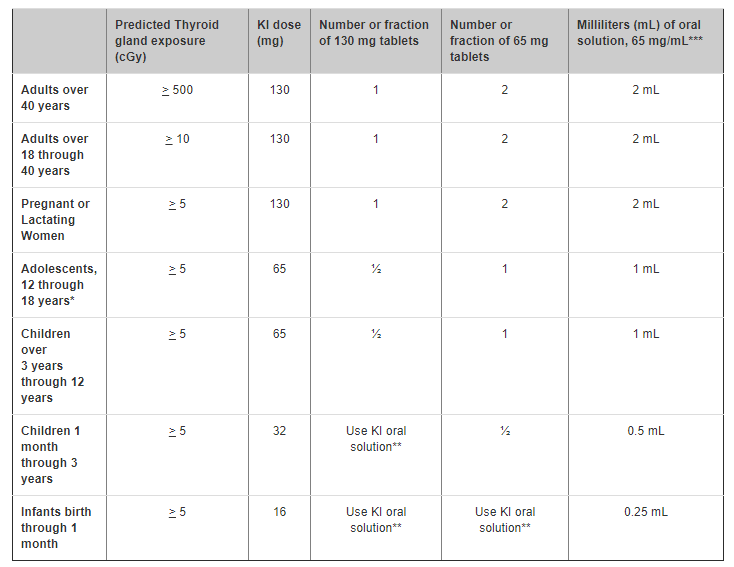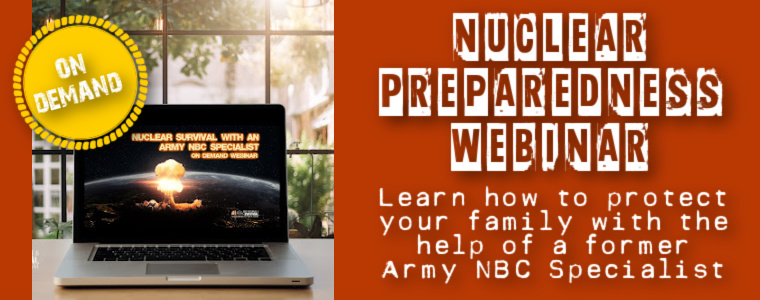If you're new here, you may want to subscribe to my RSS feed. Thanks for visiting!
By the author of Be Ready for Anything and the course Bloom Where You’re Planted
Given the current concerns, you may be adding some emergency supplies that you are unfamiliar with to your pantry and medicine cabinet. This article explains how to use potassium iodide after a nuclear strike and addresses some frequently asked questions.
At the end, there’s a link to a downloadable format of this article that you can print out to keep with your emergency supplies. I’m not a doctor – this article is based on research done on the FDA and CDC websites. Sources are cited at the end.
(You can find this information and more in our printable Nuclear Survival Anthology.)
(The abbreviation for potassium iodide is KI, which I’ll use for the rest of the article.)
Why you need potassium iodide after a nuclear emergency
Aside from the immediate threats of a nuclear blast, the thyroid gland is the most susceptible organ to damage from radiation. Potassium iodide is a stable form of iodine (stable meaning it isn’t radioactive.) If the thyroid gland is loaded with stable iodine, it can’t absorb radioactive iodine. Radioactive iodine can cause cancer. Here’s how the CDC explains it:
The thyroid gland cannot tell the difference between stable and radioactive iodine. It will absorb both. KI (potassium iodide) blocks radioactive iodine from entering the thyroid. When a person takes KI, the stable iodine in the medicine gets absorbed by the thyroid. Because KI contains so much stable iodine, the thyroid gland becomes “full” and cannot absorb any more iodine—either stable or radioactive—for the next 24 hours.
This doesn’t protect your body from any other type of radioactive isotopes – only radioactive iodine. It won’t undo the damage done by radioactive iodine, so you must begin taking it immediately for protection. If there is no radioactive threat, you should not take KI, as it can be harmful.
(For more information on how to survive a nuclear strike, check out our nuclear survival anthology.)
How do you take potassium iodide after a nuclear strike or other radiation emergency?
The sooner you begin taking KI after an emergency, the better. It works best if taken within 3-4 hours of an emergency.Here are the dosages recommended by the FDA.
Here are the dosages recommended by the FDA.
- Newborns from birth to 1 month of age should be given 16 mg (¼ of a 65 mg tablet or ¼ mL of solution). This dose is for both nursing and non-nursing newborn infants.
- Infants and children between 1 month and 3 years of age should take 32 mg (½ of a 65 mg tablet OR ½ mL of solution). This dose is for both nursing and non-nursing infants and children.
- Children between 3 and 18 years of age should take 65 mg (one 65 mg tablet OR 1 mL of solution).
- Children who are adult size (greater than or equal to 150 pounds) should take the full adult dose, regardless of their age.
- Adults should take 130 mg (one 130 mg tablet OR two 65 mg tablets OR two mL of solution).
- Women who are breastfeeding should take the adult dose of 130 mg.
Here’s a chart provided by the FDA.
One full dose protects the thyroid gland for 24 hours. Taking more does not add more protection and can cause illness or death. During times of extended exposure, take the dose once every 24 hours for the length of time recommended by emergency officials. (You’ve got your battery-operated or hand crank emergency radio, right?)
The following guidance is offered by the FDA:
- The FDA guidance prioritizes groups based on age, which is the primary factor for determining risk for radioiodine-induced thyroid cancer.
- Those at highest risk are infants and children, as well as pregnant and nursing females because of the potential for KI to suppress thyroid function in the developing fetus and the newborn.
- The recommendation is to treat them at the lowest threshold (with respect to predicted radioactive dose to the thyroid).
- Anyone over 18 years old and up to 40 years old should be treated at a slightly higher threshold.
- Anyone over 40 years old should be treated with KI only if the predicted exposure is high enough to destroy the thyroid and induce lifelong hypothyroidism (thyroid deficiency).
REMEMBER: DO NOT GIVE INFANTS, PREGNANT WOMEN, OR BREASTFEEDING WOMEN MORE THAN ONE DOSE OF KI.
Who should NOT take potassium iodide?
Some people should not take KI because the risks outweigh the benefits. According to the FDA, the following people should not take KI:
- Persons with known iodine sensitivity
- Persons with allergies to iodine, iodide, and shellfish
- Individuals with dermatitis herpetiformis and hypocomplementemic vasculitis
- People with nodular thyroid with heart disease should not take KI.
- Individuals with multinodular goiter, Graves’ disease, and autoimmune thyroiditis should be treated with caution — especially if dosing extends beyond a few days. Speak to your doctor, because KI could be deadly for you.
A seafood or shellfish allergy does not necessarily mean that you are allergic or hypersensitive to iodine, but extreme caution should be used, and you should have the supplies on hand to treat a life-threatening allergic reaction. Personally, I probably would not take KI if I had a seafood allergy. If you are not sure if you should take KI, consult your healthcare professional before a disaster ever occurs.
If your thyroid gland has been removed, you will not benefit from taking KI.
What are the possible side effects of potassium iodide?
If you take the correct dosage and are not allergic to iodine, you shouldn’t have any negative side effects. The possible issues are:
- Skin rashes
- Swelling of the salivary glands
- “Iodism” (metallic taste, burning mouth and throat, sore teeth and gums, symptoms of a head cold, and sometimes upset stomach and diarrhea)
- An allergic reaction can have more serious symptoms. These include fever and joint pains; swelling of parts of the body (face, lips, tongue, throat, hands, or feet); trouble breathing, speaking, or swallowing; wheezing or shortness of breath. Severe shortness of breath requires immediate medical attention.
What kind of potassium iodide should I use for my emergency supplies?
Table salt, iodine-rich foods, and low-dose supplements do not contain enough iodine to be effective.
The FDA has approved these brands for use in a nuclear emergency. (I’ve included links to the products I could find.) The FDA recommends that you only take the following brands.
- iOSAT tablets, 130mg, from Anbex, Inc.
- ThyroSafe from Mira Safety
If you are unable to find the brands above, other products that have not been recommended by the FDA are:
- Pure Potassium Iodide Crystals ( these are to be used to make a solution.)
- Iodoral (These are lower dosage, but high quality, so adjust your intake based on the recommendations above)
- Potassium Iodide tablets (Similar dosage to iOstat, but I’m unfamiliar with the brand)
It’s essential to note that if you use a non-approved product, it may not be as effective as the approved products. I strongly urge you to get the recommended brands if possible.
You will have to calculate the appropriate doses with the recommendations above.
If you live near a nuclear plant, you may be able to acquire potassium iodide free of charge from the facility.
Sources:
- KI in Radiation Emergencies
- Potassium Iodide as a Thyroid Blocking Agent in Radiation Emergencies
- FDA
- CDC
Other nuclear emergency resources:
- How to Prepare for a Nuclear Attack
- Nuclear War Survival Skills, by Cresson Kearney, the inventor of the Kearney Fallout Meter (FREE DOWNLOAD)
Go here to get a printable PDF version of this article.
This is a good thing to print out for your emergency binder. Also, keep a copy with your KI pills.
About Daisy
Daisy Luther is a coffee-swigging, adventure-seeking, globe-trotting blogger. She is the founder and publisher of three websites. 1) The Organic Prepper, which is about current events, preparedness, self-reliance, and the pursuit of liberty; 2) The Frugalite, a website with thrifty tips and solutions to help people get a handle on their personal finances without feeling deprived; and 3) PreppersDailyNews.com, an aggregate site where you can find links to all the most important news for those who wish to be prepared. Her work is widely republished across alternative media and she has appeared in many interviews.
Daisy is the best-selling author of 5 traditionally published books, 12 self-published books, and runs a small digital publishing company with PDF guides, printables, and courses at SelfRelianceand Survival.com You can find her on Facebook, Pinterest, Gab, MeWe, Parler, Instagram, and Twitter.



















Thank you Daisy!
Very necessary information. Thank you.
Thank you for pointing out that potassium iodide is not an overall radiation protection. So many fail to include that it does not protect against all types of radiation. Too many ppl think that it will save their lives, not understanding that in the event of a nuclear reaction, there are many types of radiation that need to be considered.
I have 3 dogs and they are my life ! How much do I give them?? weights: 13, 43, 54..pounds
Potassium Iodide may not be helpful to pets. You can find more information here:
http://epi.publichealth.nc.gov/phpr/ki/docs/KI_fact_sheet_pets.pdf
The thing to remember about why you’re taking it is that you are trying to prevent thyroid cancer in the future. The cancer would be most likely to occur quite a few years after the exposure, and because of the shorter life-span of pets, the risks could outweigh the benefits.
What can you do if you do have a shellfish allergy? Take nothing? Or risk it? I always have an epi-pen and keep it current.
Do NOT take Potassium Iodide if you have a shellfish allergy. It’s not worth the immediate risk during a crisis. Since you’d be taking it for 14 days and it’s a very high dose, it would be even worse than if it was a one-time thing. Not all people with shellfish allergies are allergic to Potassium Iodide, but I wouldn’t take that chance at a time when emergency services will be overwhelmed.
In the event of a nuclear explosion or power plant melt down, I assume our pets and farm animals would likewise be affected same as humans. I looked in the FDA site regarding pets, but I failed to understand the outcome of the studies. CDC also makes no mention of the protection of our pets. what would you suggest for their protect our animals?